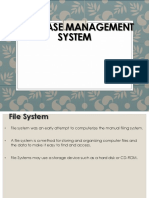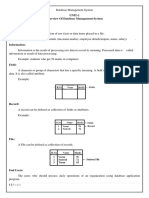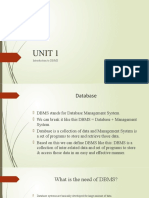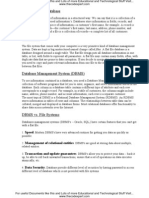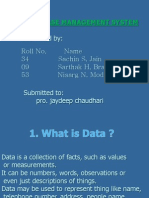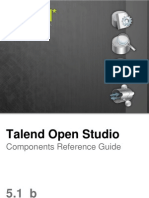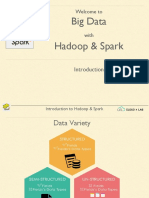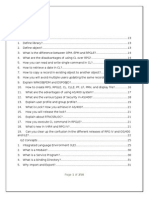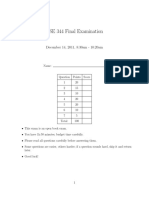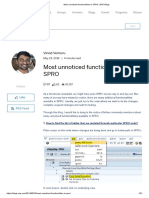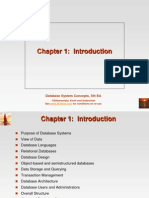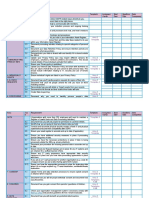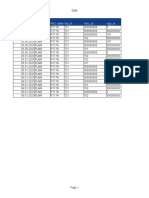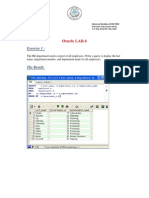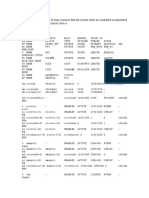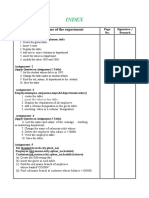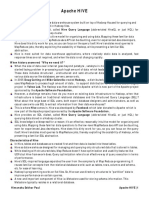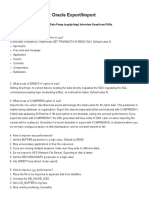Q)What is data?
data are pieces of information or facts related to the object
being considered. For example, examples of data relating to
an individual would be the person’s name, age, height, weight,
ethnicity, hair color, and birthdate. Data is not limited to facts
themselves, as pictures, images, and files are also considered
data
.……End………………
Q)What is Database?
The database is a collection of inter-related data which is used
to retrieve, insert and delete the data efficiently. It is also used
to organize the data in the form of a table, schema, views, and
reports, etc.
For example: The college Database organizes the data about
the admin, staff, students and faculty etc.
Using the database, you can easily retrieve, insert, and delete
the information.
……..END……………….
Q)Database Management System?
o Database management system is a software which is
used to manage the. For example: MySQL, Oracle, etc are
a very popular commercial database which is used in
different applications.
o DBMS provides an interface to perform various
operations like database creation, storing data in it,
updating data, creating a table in the database and a lot
more.
o It provides protection and security to the database. In the
case of multiple users, it also maintains data
consistency.
o DBMS allows users the following tasks:
o Data Definition: It is used for creation, modification, and
removal of definition that defines the organization of data
in the database.
o Data Updation: It is used for the insertion, modification,
and deletion of the actual data in the database.
o Data Retrieval: It is used to retrieve the data from the
database which can be used by applications for various
purposes.
o User Administration: It is used for registering and
monitoring users, maintain data integrity, enforcing data
security, dealing with concurrency control, monitoring
performance and recovering information corrupted by
unexpected failure.
Characteristics of DBMS:
o It uses a digital repository established on a server to
store and manage the information.
o It can provide a clear and logical view of the process that
manipulates data.
o DBMS contains automatic backup and recovery
procedures.
o It contains ACID properties which maintain data in a
healthy state in case of failure.
o It can reduce the complex relationship between data.
o It is used to support manipulation and processing of data.
o It is used to provide security of data.
o It can view the database from different viewpoints
according to the requirements of the user.
………END………….
Q)information?
Information is the processed, organised and structured
data. It provides context for data and enables decision
making.
Example:survey reports and results,students merit list,
The average score of a class
….,…..END……
Q)File-based System?
A file is a collection of data (or) program instructions.One table is
stored in single file,then this file is known as flat file.File system
organising the files with a hard disk (or) medium storage.It helps
in reading and writting data to the hard disk and easily retrieval of
files when they are required. It is compatible with different file
types,such as MP3,doc,text,pdf etc.
Each file in independent from one another .
Drawbacks of File system:
• Duplication of data:duplication of data means same
data being stored more than once.This can also be
termed as data redundancy.The main draw back of
duplication data are:
• I)duplication of data leads to wastage of storage
space.
• Ii)if the storage space is wasted it will have a direct
impact on cost.The cost will increase
• Data inconsistency: Due to the effect of data
redundancy this often leads to data inconsistency.
Which means that the same copies of data located in
different places contain different values. For preventing
this, there should be paper listing among different .
• .Data Isolation: If the data is stored in different
locations, this could essentially mean that they are
isolated in file management system. Under this
circumstances, the formats of each file can vary
significantly. As a result, extracting data from files can
be difficult as it requires complex programming.
• Dependency on application programs: Changing
files would lead to change in application programs.
• Atomicity issues: Atomicity refers to the data that is
incomplete. This often happens if the data is either
completely entered or not entered at all. For an example,
your system could fail in the middle of a transaction leading
to data atomicity. Unlike in database management system, it
is difficult to ensure atomicity in file management system.
• Data Security: Database should be accessible in a limited
way to different users.
• Each user are allowed to access only those data, which is
required for his/her application.
• ………END…
Q)Data models?
Ans: Data models define how the logical structure of a database
is modeled. Data models define how data is connected to each
other and how they are processed and stored inside the system.
1.Entity-Relationship Model:
Entity-Relationship (ER) Model is based on the notion of real-
world entities and relationships among them. the ER Model
creates entity set, relationship set, general attributes and
constraints.
ER Model is based on −
• Entities and their attributes.
• Relationships among entities.
These concepts are explained below.
• Entity − An entity in an ER Model is a real-world entity having
properties called attributes. Every attribute is defined by its
set of values called domain. For example, in a school
database, a student is considered as an entity. Student has
various attributes like name, age, class, etc.
• Relationship − The logical association among entities is
called relationship. Relationships are mapped with entities
in various ways. Mapping cardinalities define the number of
association between two entities.
Mapping cardinalities −
o one to one
o one to many
o many to one
o Many to many
Example:
2.Relational Data Model: This type of model designs the data in
the form of rows and columns within a table. Thus, a relational
model uses tables for representing data and in-between
relationships. Tables are also called relations. The relational data
model is the widely used model which is primarily used by
commercial data processing applications.
The main highlights of this model are −
• Data is stored in tables called relations.
• Relations can be normalized.
• In normalized relations, values saved are atomic values.
• Each row in a relation contains a unique value.
• Each column in a relation contains values from a same
domain.
3.Object-based Data Model: An extension of the ER model with
notions of functions, encapsulation, and object identity, as well.
This model supports a rich type system that includes structured
and collection types. Thus, in 1980s, various database systems
following the object-oriented approach were developed. Here, the
objects are nothing but the data carrying its properties.
4.Semistructured Data Model: This type of data model is
different from the other three data models (explained above). The
semi structured data model allows the data specifications at
places where the individual data items of the same type may have
different attributes sets. The Extensible Markup Language, also
known as XML, is widely used for representing the semistructured
data.
…..End…
Q) components of DBMS?
Ans: Hardware, Software, Data, Database Access Language,
Procedures and Users all together form the components of a
DBMS.
1.Hardware:
The hardware is the actual computer system used for keeping and
accessing the database. The conventional DBMS hardware
consists of secondary storage devices such as hard disks.
Databases run on the range of machines from micro computers to
mainframes.
2.Software:
This is the set of programs used to control and manage the overall
database. This includes the DBMS software itself, the Operating
System, the network software being used to share the data among
users, and the application programs used to access data in the
DBMS.
3.Data:
Database Management System collects, stores, processes, and
accesses data. The Database holds both the actual or operational
data and the metadata.
4.procedure:
Procedures refer to general instructions to use a database
management system. This includes procedures to setup and install
a DBMS, To login and logout of DBMS software, to manage
databases, to take backups, generating reports etc.
5.Database Access Language:
Database Access Language is a simple language designed to
write commands to access, insert, update and delete data stored
in any database.
A user can write commands in the Database Access Language and
submit it to the DBMS for execution, which is then translated and
executed by the DBMS.
User can create new databases, tables, insert data, fetch stored
data, update data and delete the data using the access language.
6.Users:
• The users are the people who control and manage the
databases and perform different types of operations on the
databases in the database management system.
There are three types of user who play different roles in DBMS:
• Application Programmers
Database Administrators
• End-Users
1. Application Programmers
The users who write the application programs in programming
languages (such as Java, C++, or Visual Basic) to interact with
databases are called Application Programmer.
2. Database Administrators (DBA)
A person who manages the overall DBMS is called a database
administrator or simply DBA.
3. End-Users
The end-users are those who interact with the database
management system to perform different operations by using the
different database commands such as insert, update, retrieve,
and delete on the data, etc.
…….END…
Q) three schema architecture of database?
1. Physical Level (or) internal level: This level is also
known as physical level. This level describes how the data
is actually stored in the storage devices. This level is also
responsible for allocating space to the data. This is the
lowest level of the architecture.
2.Conceptual Level: It is also called logical level. The
whole design of the database such as relationship among
data, schema of data etc. are described in this level.
Database constraints and security are also implemented in this
level of architecture. This level is maintained by DBA (database
administrator).
3.external Level: It is also called view level. The reason this
level is called “view” is because several users can view their
desired data from this level which is internally fetched from
database with the help of conceptual and internal level
mapping. External level is the “top level” of the Three Level
DBMS Architecture.
……END..








